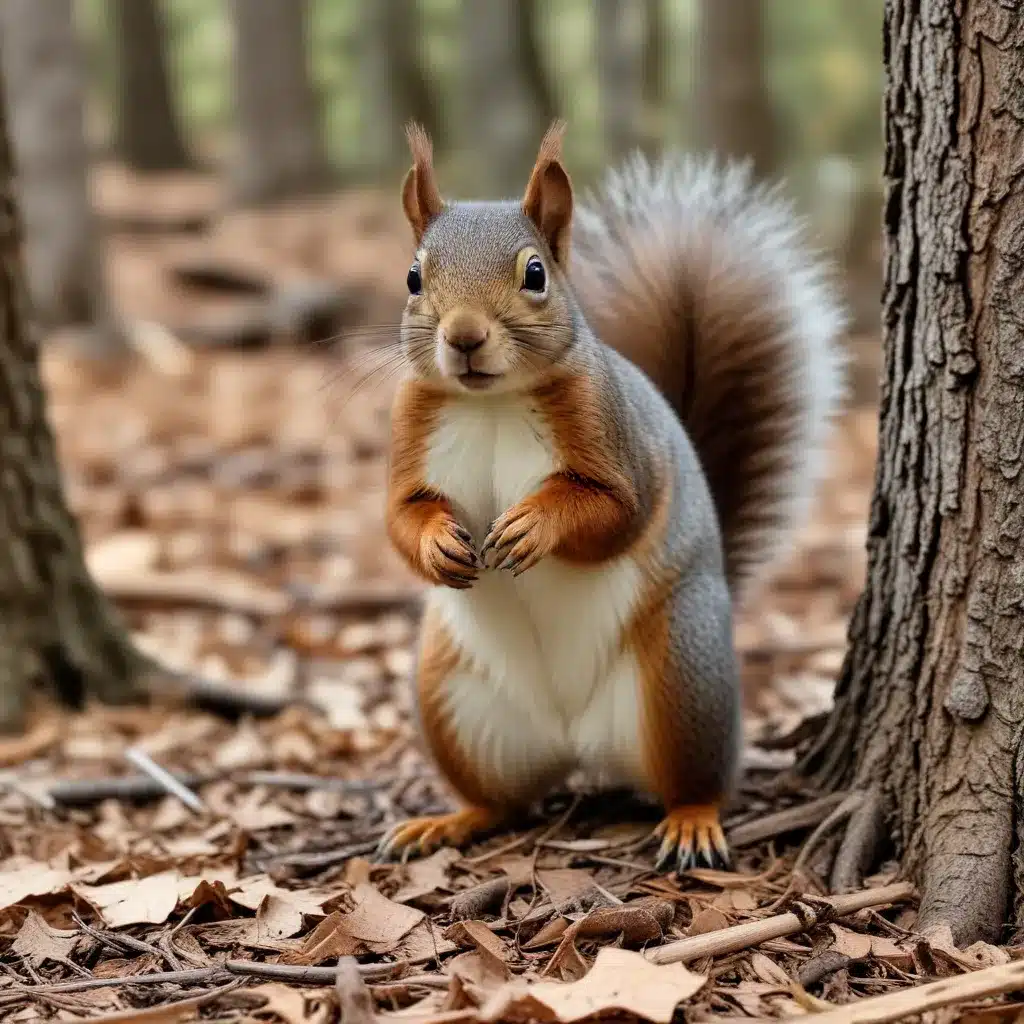
Meet the Scurrying Squirrels of Crooked Pines
At Crooked Pines Farm, we’re lucky to have a variety of fascinating squirrels darting among our trees and scampering across the forest floor. From the familiar bushy-tailed Eastern Gray Squirrel to the elusive and agile Northern Flying Squirrel, these charismatic rodents are an integral part of our vibrant ecosystem.
Squirrel Species of Crooked Pines
The Common Eastern Gray Squirrel is undoubtedly the most prevalent squirrel species on our farm. With their distinctive gray coats, tufted ears, and large, fluffy tails, these nimble acrobats can be seen foraging for nuts and seeds, or rapidly leaping from branch to branch. Their cheerful chatter and daring antics often delight our visitors, especially the youngest ones.
We’re also home to a smaller population of Southern Flying Squirrels, which are a real treat to spot. These nocturnal, gliding specialists have a unique adaptation – a furry membrane called a “patagium” that stretches between their front and hind legs, allowing them to effortlessly soar from tree to tree. With their large, round eyes and soft, gray-brown fur, they appear almost ethereal as they float silently through the night.
Occasionally, we’ll catch a glimpse of the more elusive Thirteen-Lined Ground Squirrel, also known as the “Striped Gopher.” These small, burrow-dwelling squirrels can be found scurrying across our meadows, their sleek, tan bodies marked with distinctive white stripes. Unlike their arboreal cousins, they spend most of their time foraging on the ground, darting in and out of intricate tunnel systems.
Squirrel Behavior at Crooked Pines
Throughout the year, we observe the fascinating behaviors of our resident squirrels. In the fall, they can be seen frantically gathering and hoarding nuts, seeds, and other edible treasures to sustain them through the winter months. Their large, domed nests – called “dreys” – are often visible high up in the branches, providing cozy shelters for raising their young.
The squirrels’ vocal repertoire is equally captivating. Their distinctive chittering and trilling calls echo through the trees, serving as a means of communication, whether they’re alerting the others to a potential threat or simply chattering with their neighbors.
Crooked Pines Ecosystem
The squirrels at Crooked Pines are just one part of our diverse and thriving ecosystem. Our farm is home to a rich tapestry of flora and fauna, each playing a vital role in the delicate balance of our natural world.
Our towering pine trees and sturdy oak groves provide essential food and shelter for a wide range of species, from the songbirds that nest in their branches to the small mammals that burrow beneath their roots. The understory plants, such as vibrant wildflowers and lush ferns, create a verdant, layered landscape that supports a myriad of insects and pollinators.
In turn, these creatures contribute to the overall health and resilience of our farm. The birds that feast on our squirrels’ cache of nuts help to spread and germinate new tree seedlings, while the insects pollinate our flowering plants, ensuring a bountiful harvest. Even the mammals, like the foxes and owls that prey on the squirrels, play a crucial role in maintaining a balanced, thriving ecosystem.
Squirrel Adaptations
The squirrels of Crooked Pines have evolved a remarkable array of physical and behavioral adaptations to thrive in our diverse environment.
Their sharp claws and flexible joints allow them to scurry up tree trunks, navigate the intricate web of branches, and even descend headfirst with ease. Their bushy, often reddish-brown tails not only provide balance and aid in their acrobatic feats but also serve as a form of insulation during the colder months, helping them to conserve precious body heat.
Behaviorally, the squirrels have mastered the art of caching, or storing, their food for the winter. They bury their nuts and seeds in various locations, sometimes even creating “larders” – underground storage units – to ensure a steady supply of sustenance during the lean times. The flying squirrels take this behavior one step further, using their unique gliding abilities to transport their cache between trees, making it harder for predators to locate.
For the ground-dwelling squirrels, hibernation is a crucial adaptation. As the temperatures plummet, they retreat deep into their burrows, entering a state of torpor to conserve energy and survive the harsh winter months. In contrast, the arboreal species remain active year-round, relying on their stored food and warm, insulated nests to weather the cold.
Conservation Efforts at Crooked Pines
At Crooked Pines Farm, we are committed to preserving the habitats that support our diverse array of squirrels and other wildlife. Through careful land management and reforestation efforts, we work to maintain a healthy, thriving ecosystem that provides ample food, shelter, and breeding grounds for these captivating creatures.
Our wildlife protection protocols include hunting regulations, citizen science initiatives, and educational programs that engage our visitors in the importance of squirrel conservation. By fostering a deeper understanding and appreciation for these charismatic rodents, we hope to inspire our community to join us in safeguarding their future.
So, the next time you visit Crooked Pines, keep your eyes peeled for the scurrying, gliding, and burrowing squirrels that call our farm home. Their boundless energy, remarkable adaptations, and essential role in our ecosystem are a true wonder to behold. Come explore the world of squirrels at Crooked Pines – you’re sure to be charmed by these spirited, resilient, and indispensable members of our vibrant farm community.


